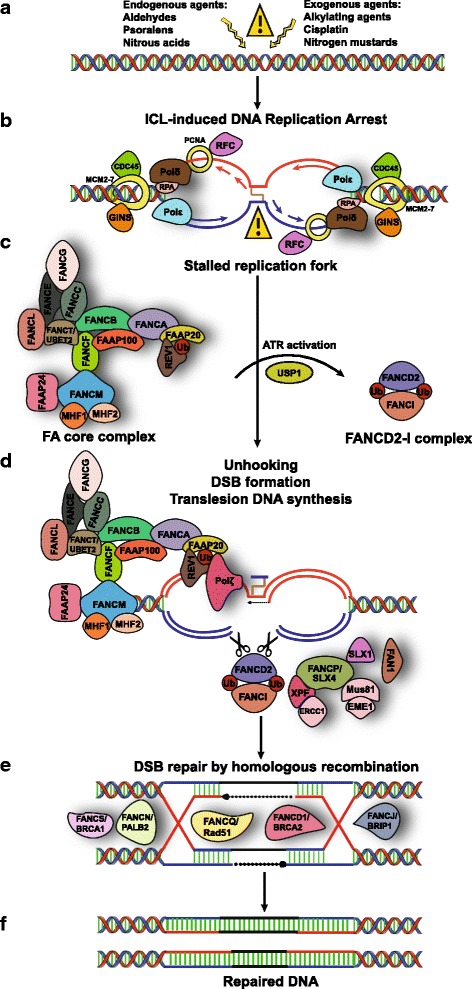Fig. 1.

A model for the DNA interstrand crosslink (ICL) repair: Crosstalk between the Fanconi Anemia (FA) pathway, translesion synthesis (TLS) and homologous recombination (HR). a Certain endogenous, environmental sources and chemotherapeutic agents inflict damage to the DNA forming adducts between each DNA strands creating inter-strand crosslinks. b Two replication forks converge at the DNA ICL covalently linking the Watson and Crick strands of the DNA. The replication machinery encounters the DNA lesion at the fork leading to fork stalling. c The FA core complex detects the stalled replication fork, assembles on the DNA lesion and initiates checkpoint response by activating ATR, which in turn phosphorylates multiple FA proteins. This triggers the ubiquitin ligase activity of FANCL resulting in monoubiquitination of FANCD2 and FANCI. d The FANCD2-FANCI heterodimeric complex is recruited to the ICL site. This further recruits downstream nucleases, in particular structure specific endonucleases like SLX4 (FANCP), ERCC1-XPF, FAN1 and MUS81-EME1 to coordinate nucleolytic incisions flanking the ICL. The incisions unhook the ICL leaving crosslinked nucleotides tethered to the complementary strand. FAAP20 interacts with the FA core complex and binds to monoubiquitinated REV1. This catalyze TLS-dependent lesion bypass across the adduct, mediated by specialized TLS polymerases such as REV1 and Polζ. This restores the integrity of the template strand required for the progression of the nascent leading strand. e DSB generated after nucleolytic incisions serves as a suitable substrate for repair by the HR pathway. Downstream FA proteins promote RAD51-dependent strand invasion forming the synaptic filament. Branch migration and intermediates containing Holliday junctions are formed. f The resulting double Holliday junction is resolved by HR specific nucleases, HR repair is completed and the integrity of the DNA is restored
